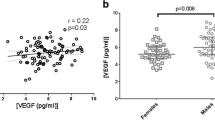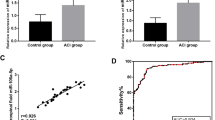Summary
This study was carried out to investigate the role of intrinsic neuroprotective mechanisms in the occurrence and development of vascular cognitive impairment (VCI) with the goal of providing a target for the treatment and prevention of VCI. Inpatients with proven cerebral infarction on cranial computed tomography (CT) were recruited as the ischemic cerebrovascular diseases (ICVD) group, and the patients with mixed stroke were excluded. In ICVD group, 12 patients were diagnosed as having VCI and served as VCI group. Inpatients undergoing surgical operation in our hospital were enrolled as control group. Double-antibody sandwich enzyme-linked immunosorbent assay (ELISA) was employed to detect the levels of hypoxia-inducible factor 1-alpha (HIF-1α), vascular endothelial growth factor (VEGF), nerve growth factor (NGF) and brain-derived neurotrophic factor (BDNF) in the cerebrospinal fluid of patients with ICVD. Associations between the levels of these factors and the Mini-Mental State Examination (MMSE) score were evaluated. In ICVD and VCI groups, the levels of HIF-1α and NGF in the cerebrospinal fluid were markedly lower than those in control group (P=0.037 and P=0.000; P=0.023 and P=0.005). In ICVD and VCI groups, the MMSE score was negatively related to VEGF level in the cerebrospinal fluid (r=−0.327, P=0.021; r=−0.585, P=0.046). In VCI group, HIF-1α level was correlated with NGF level (r=0.589, P=0.044). HIF-1α and NGF are involved in ischemic and hypoxic cerebral injury. The HIF signaling pathway plays an important role in intrinsic neuroprotection. Upregulation and maintenance of HIF-1α and NGF expression may attenuate VCI. Changes in VEGF levels are related to the occurrence and development of cognitive impairment.
Similar content being viewed by others
References
Moorhouse P, Rockwood K. Vascular cognitive impairment: current concepts and clinical developments. Lancet Neurol, 2008,7(3):246–255
Ruitenberg A, den Heijer T, Bakker SL, et al. Cerebral hypoperfusion and clinical onset of dementia: the Rotterdam Study. Ann Neurol, 2005,57(6):789–794
Sarti C, Pantoni L, Bartolini L, et al. Cognitive impairment and chronic cerebral hypoperfusion: what can be learned from experimental models. J Neurol Sci, 2002,203–204:263–266
Scheel P, Puls I, Becker G, et al. Volume reduction in cerebral blood flow in patients with vascular dementia. Lancet, 1999,354(9196):2137
de la Torre JC. Vascular risk factor detection and control may prevent Alzheimer’s disease. Ageing Res Rev, 2010,9(3):218–225
Farkas E, Luiten PG, Bari F. Permanent, bilateral common carotid artery occlusion in the rat: a model for chronic cerebral hypoperfusion-related neurodegenerative diseases. Brain Res Rev, 2007,54(1):162–180
de La Torre JC. Critically attained threshold of cerebral hypoperfusion: the CATCH hypothesis of Alzheimer’s pathogenesis. Neurobiol Aging, 2000,21(2):331–342
Bergeron M, Gidday JM, Yu AY, et al. Role of hypoxia-inducible factor-1 in hypoxia-induced ischemic tolerance in neonatal rat brain. Ann Neurol, 2000,48(3):285–296
Marti HJ, Bernaudin M, Bellail A, et al. Hypoxia-induced vascular endothelial growth factor expression precedes neovascularization after cerebral ischemia. Am J Pathol, 2000,156(3):965–976
Kromer LF. Nerve growth factor treatment after brain injury prevents neuronal death. Science, 1987,235:214
Koda M, Murakami M, Ino H, et al. Brain-derived neurotrophic factor suppresses delayed apoptosis of oligodendrocyes after spinal cord injury in rats. Neurotrauma, 2002,19(6):777–785
Mizuno T, Kuno R, Nitta A, et al. Protective effects of nicergoline against neuronai cell death induced by activated mineroglia and astrocytes. Brain Res, 2005, 1066(1–2):78–85
Ploughman M, Windle V, Maclellan CL, et al. Brain-derived neurotrophic factor contributes to recovery of skilled reaching after focal ischemia in rats. Stroke, 2009,40(4):1490–1495
Group of Dementia and Cognitive Impairment, Branch of Neuropathy of Chinese Medical Association. Guideline for Diagnosis and Treatment of Vascular Cognitive Impairment. Chin J Neurol (Chinese), 2011,44(2):142–147
Semenza GL. Hypoxia-inducible factor 1 (HIF-1) pathway. Sci STKE, 2007,2007(407):m8
Benarroch EE. Hypoxia-induced mediators and neurologic disease. Neurology, 2009,73(7):560–565
Sharp FR, Lu A, Tang Y, et al. Multiple molecular penumbras after focal cerebral ischemia. J Cereb Blood Flow Metab, 2000,20(7):1011–1032
Bergeron M, Yu AY, Solway KE, et al. Induction of hypoxia-inducible factor-1 (HIF-1) and its target genes following focal ischaemia in rat brain. Eur J Neurosci, 1999,11(12):4159–4170
Matsuda T, Abe T, Wu JL, et al. Hypoxia-inducible factor-lalpha DNA induced angiogenesis in a rat cerebral ischemia model. Neurol Res, 2005,27(5):503–508
Lee TH, Kato H, Chen ST, et al. Expression of nerve growth factor and trkA after transient focal cerebral ischemia in rats. Stroke, 1998,29(8):1687–1696
Hwang IK, Lee KY, Yoo KY, et al. Tyrosine kinase A but not phosphacan/protein tyrosine phosphatase-ζ/β immunoreactivity and protein level changes in neurons and astrocytes in the gerbil hippocampus proper after transient forebrain ischemia. Brain Res, 2005,1036:35–41
Wiener CM, Booth G, Semenza GL. In vivo expression of mRNAs encoding hypoxia-inducible factor. Biochem Biophys Res Commun, 1996,225(2):485–488
Stroka DM, Burkhardt T, Desbaillets I, et al. HIF-1 is expressed in normoxic tissue and displays an organ-specific regulation under systemic hypoxia. FASEB J, 2001,15(13):2445–2453
Baranova O, Miranda LF, Pichiule P, et al. Neuron-specific inactivation of the hypoxia inducible factor 1α increases brain injury in a mouse model of transient focal cerebral ischemia. J Neurosci, 2007,27(23): 6320–6332
Guo S, Bragina O, Xu Y, et al. Glucose up-regulates HIF-1α expression in primary cortical neurons in response to hypoxia through maintaining cellular redox status. J Neurochem, 2008,105(5):1849–1860
Demidenko ZN, Rapisarda A, Garayoa M, et al. Accumulation of hypoxia-inducible factor-1α is limited by transcription-dependent depletion. Oncogene, 2005,24(30):4829–4838
Kong X, Alvarez-Castelao B, Lin Z, et al. Constitutive/hypoxic degradation of HIF-1α proteins by the proteasome is independent of von Hippel Lindau protein ubiquitylation and the transactivation activity of the protein. J Biol Chem, 2007,282(21):15 498–15 505
Shweiki D, Itin A, Soffer D, et al. Vascular endothelial growth factor induced by hypoxia may mediate hypoxia-initiated angiogenesis. Nature, 1992,359(6398): 843–845
Ogunshola OO, Stewart WB, Mihalcik V, et al. Neuronal VEGF expression correlates with angiogenesis in postnatal developing rat brain. Brain Res Dev Brain Res, 2000,119(1):139–153
Kovàcs Z, Ikezaki K, Samoto K, et al. VEGF and flt: expression time kinetics in rat brain infarct. Stroke, 1996,27(10):1865–1873
Hayashi T, Abe K, Suzuki H, et al. Rapid induction of vascular endothelial growth factor gene expression after transient middle cerebral artery occlusion in rats. Stroke, 1997,28(10):2039–2044
Lennmyr F, Ata KA, Funa K, et al. Expression of vascular endothelial growth factor (VEGF) and its receptors (Flt-1 and Flk-1) following permanent and transient occlusion of the middle cerebral artery in the rat. J Neuropathol Exp Neurol, 1998,57(9):874–882
Krum JM, Mani N, Rosenstein JM. Angiogenic and astroglial responses to vascular endothelial growth factor administration in adult rat brain. Neuroscience, 2002,110(4):589–604
Hayashi T, Abe K, Itoyama Y. Reduction of ischemic damage by application of vascular endothelial growth factor in rat brain after transient ischemia. J Cereb Blood Flow Metab, 1998,18(8):887–895
Zhang ZG, Zhang L, Jiang Q, et al. VEGF enhances angiogenesis and promotes blood-brain barrier leakage in the ischemic brain. J Clin Invest, 2000,106(7):829–838
Bao WL, Lu SD, Wang H, et al. Intraventricular vascular endothelial growth factor antibody increases infarct volume following transient cerebral ischemia. Zhongguo Yao Li Xue Bao, 1999,20(4):313–318
Tarkowskia E, Issa R, Sjogren M, et al. Increased intrathecal levels of the angiogenic factors VEGF and TGF-β in Alzheimer’s disease and vascular dementia. Neurobi Aging, 2000,23(2):237–243
Larsson E, Kuma R, Norberg A, et al. Nerve growth factor R221W responsible for insensitivity to pain is defectively processed and accumulates as proNGF. Neurobiol Dis, 2009,33(2):221–228
Lee TH, Yang JT, Ko YS, et al. Influence of ischemic preconditioning on levels of nerve growth factor, brain-derived neurotrophic factor and their high-affinity receptors in hippocampus following forebrain ischemia. Brain Res, 2008,1187:1–11
Walton M, Connor B, Lawlor P. Neuronal death and survival in two models of hypoxic-ischemic brain damage. Brain Res Brain Res Rev, 1999,29(23):137–168
Schabitz WR, Schwab S, Spranger M, et al. Intraventricular brain-derived neurotrophic factor reduces infarct size after focal cerebral ischemic in rats. J Cereb Blood Flow Metab, 1997,17(5):500–506
Zhou H, Mao M, Liu WP, et al. Expression of BDNF receptor TrkBmRNA in hypoxia-induced fetal cortical neurons. Huaxi Yike Daxue Xuebao (Chinese), 2002,33(4):573–576
Nakamura K, Martin KC, Jackson JK, et al. Brain-derived neurotrophic factor activation of TrkB induces vascular endothelial growth factor expression via hypoxia-inducible factor-1alpha in neuroblastoma cells. Cancer Res, 2006,66(8):4249–4255
Nakamura K, Tan F, Li ZJ, et al. NGF activation of TrkA induces vascular endothelial growth factor expression via induction of hypoxia-inducible factor-1α. Mol Cell Neurosci, 2011,46(2):498–506
Author information
Authors and Affiliations
Corresponding author
Additional information
This project was supported by the National Natural Science Foundation of China (No. 81171029).
Rights and permissions
About this article
Cite this article
Ke, Xj., Zhang, Jj. Changes in HIF-1α, VEGF, NGF and BDNF levels in cerebrospinal fluid and their relationship with cognitive impairment in patients with cerebral infarction. J. Huazhong Univ. Sci. Technol. [Med. Sci.] 33, 433–437 (2013). https://doi.org/10.1007/s11596-013-1137-4
Received:
Published:
Issue Date:
DOI: https://doi.org/10.1007/s11596-013-1137-4




